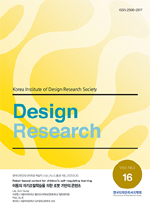- 영문명
- A Study on the Correlation between the CERS Framework and Generative AI-based Industrial Design : Focusing on the Cognitive Evaluation of Industrial Design Majors
- 발행기관
- 한국디자인리서치학회
- 저자명
- 진현오(Hyono O Jin)
- 간행물 정보
- 『한국디자인리서치』Vol10, No. 3(통권 36권), 135~147쪽, 전체 13쪽
- 주제분류
- 예술체육 > 미술
- 파일형태
- 발행일자
- 2025.09.30

국문 초록
본 연구는 생성형 인공지능(Generative AI)이 산업디자인 과정에서 사용자의 놀라움(Surprise) 경험을 어떻게 강화하는지를 탐색하고, 이를 마이클 루셀이 제안한 CERS(Conceptual, Emotional, Relational, Spiritual) 프레임에 기반하여 분석하였다. 이를 위해 선행연구 검토와 함께 나이키 A.I.R 프로젝트, 자하 하디드 건축 파빌리온, 허먼 밀러 게이밍 체어, BMW i Vision Dee 등 네 가지 대표 사례를 선정하여 정성적 분석을 수행하였다. 또한 산업디자인 전공 대학생 30명을 대상으로 설문조사를 실시하여 학년 및 성별 변수에 따른 CERS 평가 차이를 정량적으로 분석하였다. 연구 결과, 생성형 AI는 기존 디자인의 개념적 전복, 감각적 몰입, 관계적 상호작용 확장에는 효과적으로 기여하였으나, 영적 경험의 차원에서는 상대적으로 낮은 반응을 보였다. 특히 2학년 학생들이 가장 높은 놀라움 반응을 보였고, 성별 비교에서는 남성이 여성보다 전반적으로 높은 긍정적 반응을 나타냈다. 본 연구는 CERS 척도의 디자인 적용 가능성을 검증하고, 생성형 AI와 인간 디자이너 간 협업의 새로운 가치를 제시했다는 점에서 학문적·실천적 의의를 가진다. 다만 표본의 한정성, 사례 수의 제한, 행동 데이터 미반영 등의 한계가 존재하며, 향후 연구에서는 다양한 집단과 장르 확장을 통한 심층적 분석이 필요하다.
영문 초록
This study explores how Generative Artificial Intelligence (Generative AI) enhances the experience of surprise in industrial design, using Michael Roussel’s CERS framework (Conceptual, Emotional, Relational, Spiritual). Through literature review and qualitative case analysis, four representative examples—Nike A.I.R Project, Zaha Hadid Architects’ AI Pavilion, Herman Miller Gaming Chair, and BMW i Vision Dee—were examined in relation to CERS dimensions. In addition, a survey with 30 industrial design students was conducted to quantitatively assess differences in CERS evaluations by academic year and gender. The findings reveal that Generative AI effectively contributes to conceptual disruption, sensory immersion, and relational interaction, while the spiritual dimension elicited comparatively lower responses. Notably, sophomore students reported the highest levels of surprise, and male respondents generally showed stronger positive reactions than females. This study holds academic and practical significance by verifying the applicability of the CERS scale to design evaluation and highlighting the collaborative potential of AI and human designers. However, limitations include the restricted sample group, limited number of cases, and lack of behavioral data. Future research should expand the participant pool and case diversity for deeper insights.
목차
1. 서론
2. 이론적 배경
3. 분석 및 논의
4. 결론
참고문헌
해당간행물 수록 논문
참고문헌
최근 이용한 논문
교보eBook 첫 방문을 환영 합니다!

신규가입 혜택 지급이 완료 되었습니다.
바로 사용 가능한 교보e캐시 1,000원 (유효기간 7일)
지금 바로 교보eBook의 다양한 콘텐츠를 이용해 보세요!



